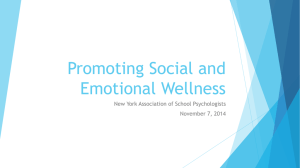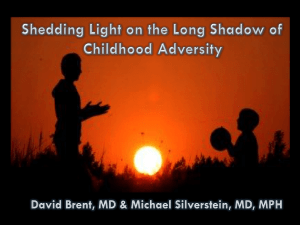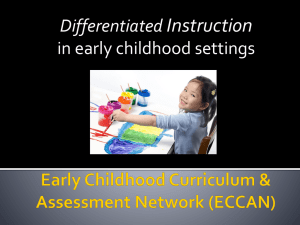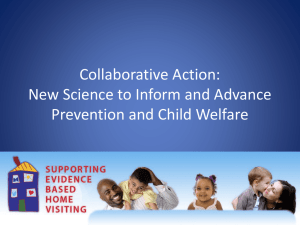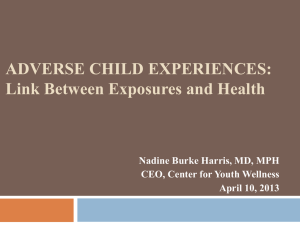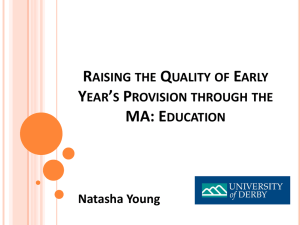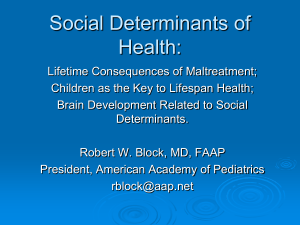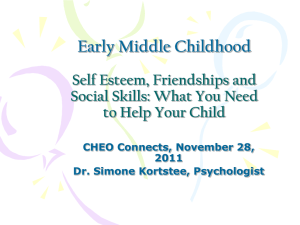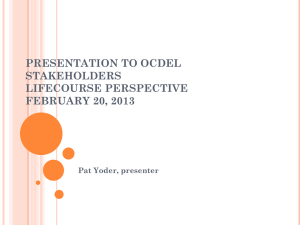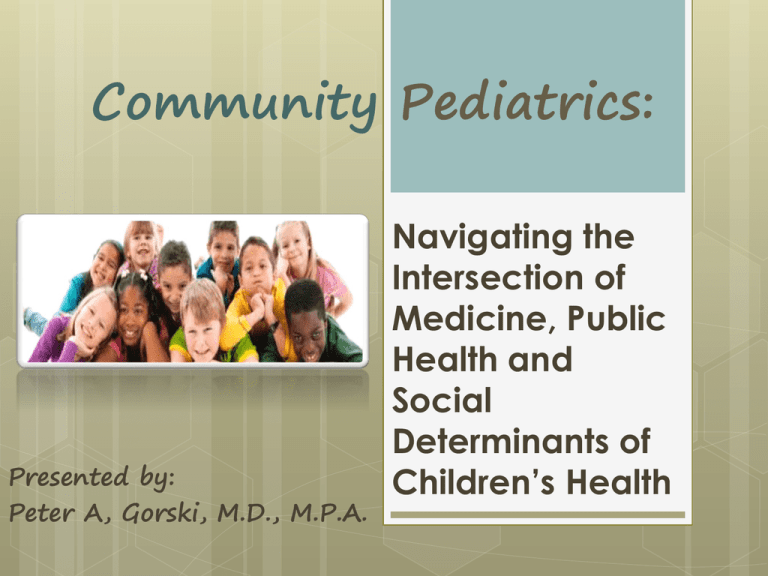
Community Pediatrics:
Presented by:
Peter A, Gorski, M.D., M.P.A.
Navigating the
Intersection of
Medicine, Public
Health and
Social
Determinants of
Children’s Health
Definition
The practice of promoting the salutary and
integrating the salutary and threatening social,
cultural and environmental influences on
children’s health and development within a
community.
Community Pediatrics Includes:
Expanded
focus beyond each child to all
children
Health and development affected by family,
educational, social, cultural, spiritual, economic,
environmental and political forces
Synthesis of clinical practice and public health
principles – children’s health in context of family,
school and community
Collaboration
with community partners to
provide services and conditions equitably
Exemplars
Infant
mortality
Preventable infectious diseases
Dental caries
Sedentary lifestyles
Chronic conditions
Obesity/Metabolic syndrome
Other historically adult-onset diseases
Injuries – intentional and unintentional
Violence
Exposure to environmental toxicants
Substance abuse and mental health conditions
Poverty
Social Determinants of Health
Life
Course Perspective and Early Programming
Epigenetics
Childhood
obesity and adult cardiovascular
disease
Inadequate calcium and Vitamin D intake in
childhood and adult osteoporosis
Childhood maltreatment and adult mental and
physical health problems – e.g. depression, high Creactive protein, inflammation and heart disease
Health care but one of several key influences on
children’s health and well-being as children move
through other primary systems, services and
environments.
Brains
Built
over time, from bottom up
Genes and experiences together build
brain architecture and physiology
(function) through “serve and return”
process of relationships.
Cognitive, social and emotional
development are inextricably intertwined.
Therefore programs must work to protect
and stimulate all levels.
Brain Development
Weight
of brain 333 Grams at birth; 999
Grams at 2 years
Born with a finite number of neurons but
connection cells (synapses) based on
early experiences – e.g. language
fluency
1 day old’s breathing patterns decipher
and change from Mozart to Stravinsky to
Mozart
Vulnerability Of The Fetus To Defects During
Different Periods Of Development
Executive Function
Inhibitory
control
Working memory
Cognitive flexibility
Prefrontal
early 20’s.
cortex fully developed only in
Early Evidence of
Executive Function
Starts
early during toddlerhood
Disruption manifest in:
undercontrolled behavior
low persistence
Inattention
Poor face processing of emotions
(differentiating anger, sadness, fear)
Stanford Marshmallow Test
1
or 2 marshmallows – 4 minute test of
patience
Long-term positive correlation with school
performance, earnings, substance
dependence, SES and physical health
Stress
Mediates
development of the immune
system as well as the limbic brain system;
T cells and brain architecture
Creates susceptibility to infections,
cancers and learning disabilities
$55,000/yr for Special Ed vs. $9,000 for reg
ed
Moshe Szyf, Ph.D.
McGill
University, Montreal
Epigenetic changes to DNA are more or
less reversible
Epigenetic changes occur only in social
animals
Michael Murray, McGill
Rat
mothers who give low maternal care
(licking and feeding) produce pups who
are high stress reactors (epigenetic
changes on their glucocorticoid receptor
genes)
Not genetic
When experimentally split pup litters,
proved that behavior inherited from foster
mother not biological mother
These
epigenetic changes have longterm, even trans-generational effects and
durations.
However, they are also always open to
change.
1998 ice storm in Quebec
Whole
communities lost power and had to
adapt for a month – across SES
T-cell function of 15 year olds today
correspond with their mother’s stress levels
while pregnant during the storm
Inequities in Health Status
England
has abolished inequalities in access to
healthcare.
Still they have gross inequalities in health
Reason: most arise from social inequalities, how
they live.
What good does it do to treat people’s illnesses
and send them back to conditions that made
them sick?!
Unequal Life Expectancy
7
year difference between 5th% and 95% on
social gradient
17
year difference
Westminster
32
in
London
year difference in Chicago
borough
of
Essential Foundations for Healthy
Development
Fostering
healthy relationships in the lives of
children (raising social capital)
Promoting high quality learning environments
and health literacy (raising educational capital)
Promoting shared prosperity and financial
stability for all members of the community
(raising economic capital)
Promoting healthy environments and supportive
infrastructure (raising environmental capital)
Environments
Toxic
exposures:
e.g. mold, heavy metals, fluorocarbons
Unsafe housing
Limited play and green spaces
Limited
convenient and affordable public
transportation
Access for children with special needs
All Needs are Equally Important
Physical
needs will not be met without
education, play, respect and freedom from
discrimination
Children’s
needs are interdependent
Income Inequality
Proxy
for more profound inequalities that create
unequal sense of worth, efficacy
Income
matters more when other primary
supports are not equitably provided
•
Healthcare, education, childcare, transportation,
workplace environment and security, collective
efficacy and social cohesion (epidemiology of
depression and smoking)
Economic Prosperity
1/3
unqualified to perform manufacturing jobs
U.S. productivity gap mirrors education gap
83% of HS students not proficient in math and
reading comprehension
83% of children from low-income families at
risk for not graduating, cutting earnings in half
($260,000 per drop out - cost to society)
($320,000 added to economy by every class
of 20 kindergarteners who succeed)
30% of Americans hold college degree, need
60% by 2025 to remain globally competitive
National Security
75%
of 17-24 year olds unfit for military service
Fail Armed Forces Qualification Test of basic
knowledge on math, literacy and problemsolving
Overweight and physically unfit
Mentally or emotionally unfit
Left Behind By Kindergarten:
Children living in poverty average 15 IQ points below their peers.
Vocabulary at Age 3
Poor children: 525 words
Working class: 749 words
Professional: 1,116 words
By age 4, the average child in
a poor family might have been
exposed to 13 million fewer
words than child in a working
class family and 30 million
fewer words than a child in a
professional family.
Sensitive Periods
Poor
living conditions early in life (nutrition,
fetal and infant growth, recurrent infections)
and increased cardiovascular, respiratory and
psychiatric diseases in adulthood.
LBW and risk for heart disease: hypertension,
central body fat distribution, insulin resistance,
metabolic syndrome and type 2 diabetes.
Dutch famine of 1944 and CHD 50 years later
Effects Of Extreme Deprivation
Healthy Child
Child
Neglected
Courtesy of Dr. H.T. Chugani from the Children’s Hospital of Michigan,
Wayne State University
Barker Hypothesis
Birth Weight and Coronary Heart Disease
Rich-Edwards JW, Stampfer MJ, Manson JE, Rosner B, Hankinson SE, Colditz GA et al. Birth weight and risk
of cardiovascular disease in a cohort of women followed up since 1976. Br Med Jr 1997;315:396-400.
Adverse Childhood Experiences
•
•
•
•
•
•
•
Physical, emotional or sexual
abuse
Emotional or physical neglect
Growing up with family
members with mental illness,
alcoholism or drug problems
Family violence
Incarcerated family member
One or no parents
Parental divorce
Adverse Childhood Experiences (ACE) Study.
Available at www.cdc.gov/ace/index.htm
39
Risk Factors for Adult Substance Abuse are
Embedded in Adverse Childhood Experiences
Self-Report: Alcoholism
Self-Report: Illicit Drugs
40
16
14
%
35
12
30
10
25
8
20
6
15
4
10
2
5
0
0
0
1
2
Source: Dube et al, 2002
3
4
ACEs
0
1
2
Source: Dube et al, 2005
3
4
5+
Risk Factors for Adult Depression are Embedded in
Adverse Childhood Experiences
Odds Ratio
5
4
3
2
1
0
1
2
3
ACEs
4
5+
Source: Chapman et al, 2004
Risk Factors for Adult Heart Disease are Embedded in
Adverse Childhood Experiences
Odds Ratio
3.5
3
2.5
2
1.5
1
0.5
0
1
2
3
4
ACEs
5,6
7,8
Source: Dong et al, 2004
ACE Study Findings
Compared with people with no ACES,
those with 4 or more ACES were…
• Twice as likely to smoke,
• 7x as likely to be alcoholics,
• 6x as likely to have had sex before age
15, twice as likely to have cancer or
heart disease
• 12x more likely to have attempted
suicide
• Men with 6+ ACEs were 46x more likely
to have injected drugs than men with
no history of adverse childhood
experiences
Outcomes Associated With ACE Scores
ACEs are highly interrelated.
•
If experienced one ACE, 90% chance for 2nd category & 70% for
3rd.
•
Therefore developed ACE score for cumulative stress.
•
Clear dose-response relationship between stressors and adverse
health outcomes up to 50 years later.
•
All of the 10 most common causes of death in America.
–
In other words, should we treat this 70 year old woman as a diabetic
and hypertensive? Or, can we conceptualize her problems as
childhood sexual abuse, chronic depression, morbid obesity, diabetes,
hypertension, & coronary artery disease?
ACE Study Findings
For
those with 7+ ACEs, even when
they didn't smoke or drink & weren't
overweight, they still had 360% higher
risk of heart disease than those with 0
ACEs.
Somehow
the traumatic experiences
of early childhood had a negative
effect on their health through a
pathway that had nothing to do with
risky behaviors.
Source: Adverse Childhood Experiences (ACE) Study. Available at www.cdc.gov/ace/index.htm
Exemplars
Traumatic
early childhood events and CAD,
CPD, CA, alcoholism, depression, drug abuse.
Child maltreatment, adult depression and
inflammation associated with cardiovascular
disease
Discrimination, racism, weathering, chronic
activation of neuroendocrine stress reactivity > progressive health disparities with age.
Life Course Problems Related to
Early Life Experiences
The Cumulative Embedding
of Experience into our Biology
Over Time
Racial and Ethnic Disparities in Birth
Outcomes: A Life Course Perspective
Lu MC, Halfon N. Racial and ethnic disparities in birth outcomes: a life-course perspective.
Maternal Child Health J. 2003;7:13-30.
Poverty Sickens
• Strong connections between child health and
adult health
• Between child wealth and adult wealth
• Between child wealth and adult health
– Regardless of child’s health condition
– Regardless if social class changes from
childhood to adulthood
• Childhood poverty gets biologically
embedded
Health by Social Class
Marmot MG, Smith GD, Stansfeld S et al.Health inequalities among British civil servants: the Whitehall II
study. Lancet 1991;337:1387-1393.
Positive
Brief increases in heart rate, mild elevations
in stress hormone levels.
Tolerable
Serious, temporary stress responses,
buffered by supportive relationships
Toxic
Prolonged activation of stress response
systems in the absence of protective
relationships
Normal Stress Response: Allostasis
Maintain Stability through Change
McEwen BS. Protective and damaging effects of stress mediators. N Eng J Med. 1998;338:171-9.
Allostastic Load
McEwen BS. Protective and damaging effects of stress mediators. N Eng J Med. 1998;338:171-9.
Social Pathogens
Neighborhood
violence
Isolation – relationships, transportation
Dysfunctional schools
Child maltreatment
Family chaos
Absent parents
Poverty – Social Gradient/Social Inequalities
Food deserts and energy dense caloric intake
Unequal access to healthcare
Racial & Ethnic Disparities
Stress and CRH in Pregnancy
Genetics?
Birth weight distribution of African-born blacks
is more closely related to US-born whites than
to US-born blacks
David RJ, Collins JW. Differing birth weight among infants of U.S.-born blacks, African-born
blacks, and U.S.-born whites. N Engl J Med. 1997 Oct 23;337(17):1209-14.
Behavior?
Maternal Smoking?
Percent of Women Who Reported Smoking During pregnancy
13.6%
9.3%
African American
White
NCHS 2002
Maternal Smoking?
Infant Deaths Per 1,000 Live Births
13.2
9.2
African American Non-Smokers
White American Smokers
NCHS 2002
Prenatal Care?
Prenatal Care?
100
Percent of Live Births with First Trimester Prenatal Care
90
80
84%
74%
70
70%
85%
74%
60
50
40
30
20
10
0
African
American
Native
American
Hispanic
Asian/PI
White
NCHS 2002
Prenatal Care?
Infant Deaths Per 1,000 Live Births
12.7
5.2
African Americans First
Trimester Prenatal Care
White Americans First
Trimester Prenatal Care
NCHS 1999
Prenatal Care?
Infant Deaths Per 1,000 Live Births
12.7
7.1
African Americans First
Trimester Prenatal Care
White Americans Prenatal
Care After 1st Trimester or
None
NCHS 2002
SES?
SES?
Infant Deaths Per 1,000 Live Births
10.2
6.8
African Americans 16+ years
of schooling
White Americans <9 years of
schooling
NCHS 2002
Prenatal Stress &
Programming Of The Brain
Prenatal stress (animal model)
Hippocampus
Site of learning & memory formation
Stress down-regulates glucocorticoid
receptors
Loss of negative feedback; overactive HPA
axis
Amygdala
Site of anxiety and fear
Stress up-regulates glucocorticoid receptors
Accentuated positive feedback; overactive
HPA axis
Welberg LAM, Seckl JR. Prenatal stress, glucocorticoids and the programming of the brain.
J Neuroendocrinol 2001;13:113-28.
Epigenetics
Vulnerability or Protection
Early
gene-environment interactions may shift
from
adaptive
to
maladaptive
and
pathogenic as environment changes –
e.g. intrauterine under nutrition, energysparing metabolic changes may create
susceptibility if early childhood environment
becomes energy abundant, carbo rich plus
sedentary lifestyle
Psychophysiological Mechanism
Low
self-control, self-efficacy and self-esteem
together cause a cascade of toxic stress that
destroys brain receptors, ability to fight
infection, inflammation and increase all-cause
mortality.
Mental
Social
health is root of physical health
justice affects mental health
I matter
I belong
I can
Investment of the State of Florida
during difficult stages of childhood
Quality Early Care and Education Pays Off:
Cost/Benefit Analyses Show Positive Returns
$9.20
$10
$8
$5.70
Total Return per
$1 Invested
$6
$4
$3.23
$2
Break-Even
Point
0
Abecedarian Project
(early care and
education aged 0-5)
Data Sources:
Karoly et al. (2005)
Nurse Family
Partnership
(home visiting
prenatal – age 2 for
high risk group)
Perry Preschool
(early education age 3-4)
Heckman et al. (2009)
Graph Courtesy: Center on the Developing Child at Harvard University
Public Investment in Children
by Age
Why Target Whole Communities?
Health and well-being of each person depends
on condition of all
Cannot predict individual course based on
group risk factors without considering the social
context
Cost burden of case-finding and treatment too
high
Moral weakness of accepting unequal outcomes
Post-neonatal Infant Mortality
(per 100,000 live births,1986)
600
500
400
300
200
100
0
I
II
III
England & Wales
IV
V
Sweden
Wilkinson RG. Income distribution and life expectancy. BMJ. 1992;304:165-168
Determinants of Health
Eco-Bio-Developmental
Model of Human Health and Disease
Biology
Physiologic Adaptations
and Disruptions
The
Science of
Development
Life Course
Science
Ecology becomes biology, and together they
drive development across the lifespan
Partnering with Public Health
Have always served as beacons for public health dangers
Reporting illness patterns, hazards and risky trends
Reciprocally, pediatricians benefit from population-based
information on programs, especially preventive services:
Injury prevention
Child maltreatment prevention
Lead poisoning
Tobacco control
Breastfeeding promotion
Obesity prevention
Asthma
Trauma
Disaster preparedness
Advocacy
Pediatricians
advocated strongly for passage of
ACA and for the needs of children (who do not
participate in government)
Legislative
advocacy training in Pediatric
Residency programs
Need for financing models for accountable care
organizations and other practices to bill for
attention to social determinants
Population Approach to Child Health
Delivers
information about early childhood
development for all children in community
Moves
focus from the individual to the entire
community to make a bigger difference
Provides
opportunity to “shift the curve” for the
whole population
Assesses
over time how the community’s
cumulative efforts are impacting children’s
development
Recommendations
Increase
use of community data about social
determinants (EDI and ECRI)
Partner with public health departments and school
districts, child welfare agencies to decrease
barriers to health and health care in communities
Disseminate information about effective community
programs and resources for children’s health and
well-being
Promote preventive health strategies at individual
and population levels
Engage with primary settings and resources for
children’s health and development
Recommendations continued…
Advocate
for universal access to medical
homes
Advocate for universal access and quality of
the social, economic, educational and
environmental capital resources for children’s
health
Speak out – use the media
Pediatric medical education and continuing
medical education should include curricula on
community
and
public
health,
social
determinants of health, health care systems and
financing, child advocacy
Children at risk for
developmental and
behavioral problems are
too often eluding early
detection
Help Me Grow is a system that
builds collaboration across
sectors, including child health
care, early care and education,
and family support.
TECCS
•
A National Partnership between UCLA Center
for Children, Families and Communities and
United Way Worldwide
•
Pioneering a new way of gathering critical
information about young children's school
readiness, neighborhood by neighborhood,
and helping communities use it to advance
early childhood system building
Early
Development
Instrument (EDI)
Patience, Persistence and the
Long View
.
Planting Date Trees
“I’d rather be dead than singing
‘Satisfaction’ when I am 45.”
Mick Jagger, DOB 1943
All Children Need and Deserve
(Emotional Foundation for Healthy Development)
• To feel connected
• To feel valued
• To feel they make a difference
Antonovsky (1984). The sense of coherence as a determinant of health. Rutter (1979). Protective factors in children’s
responses to stress and disadvantage. Erikson (1959) Growth and crises of the healthy personality .
“Few are guilty,
but all are responsible.”
Rabbi Abraham Heschel

